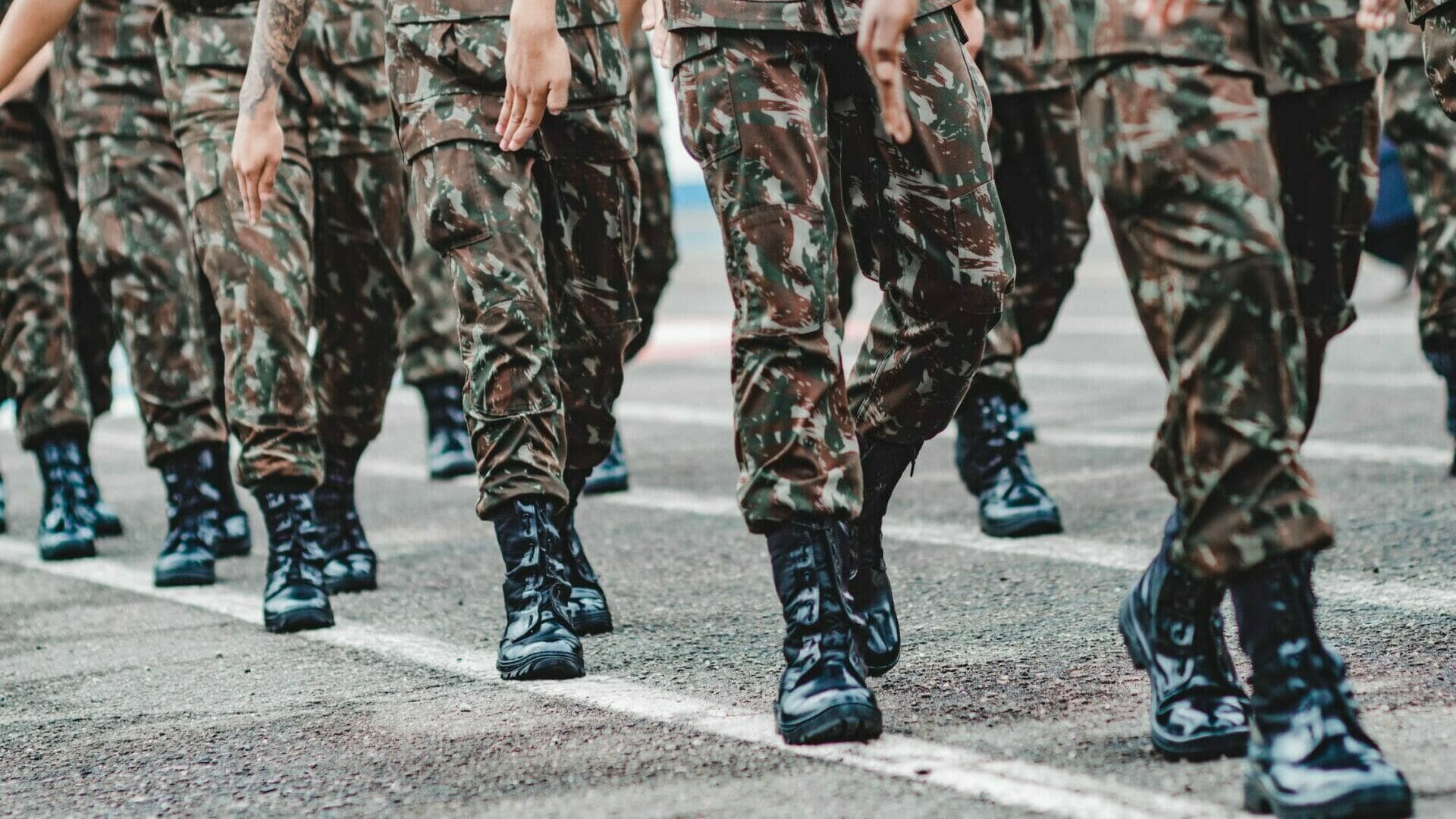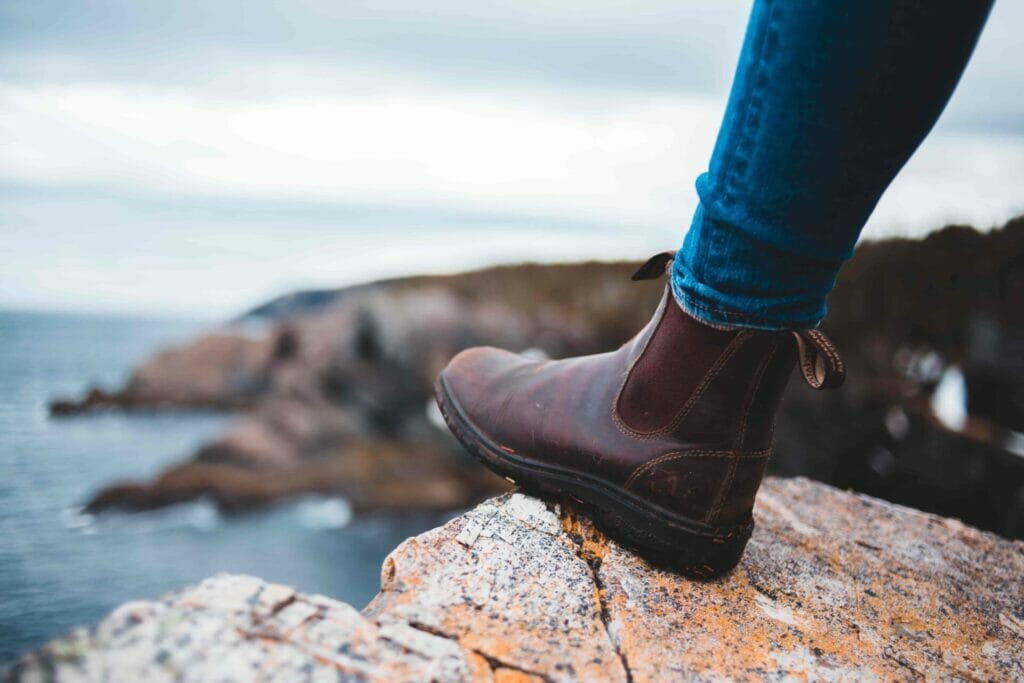The Science Behind Why Do Special Forces Wear Hiking Boots?
Special forces, such as the military, law enforcement, and search and rescue teams, operate in some of the toughest and most demanding conditions imaginable.
From rough terrain and unpredictable weather to high-intensity physical activities, these professionals require specialized gear to perform their duties effectively. One critical piece of equipment that is often overlooked is the choice of footwear.

Footwear is a critical piece of equipment for Special Forces personnel as it directly impacts their ability to perform their duties effectively. Special Forces operations involve operating in a variety of challenging environments, including rugged terrain, wet or slippery surfaces, and unpredictable weather conditions.
Special forces wear hiking boots because they provide the durability, ankle protection, waterproof and breathable materials, and high-performance qualities necessary for their missions.
With the right footwear, special forces personnel can perform their duties effectively, efficiently, and with confidence. In this article, we will explore the reasons behind this choice and provide you with a comprehensive understanding of why special forces personnel prefer hiking boots over other types of footwear.
Drawing from my personal experiences as a former military member, I will shed light on the practical and functional aspects that make hiking boots an ideal choice for these elite warriors.
Best Hiking Boots For Very Narrow Feet
Why Do Special Forces Wear Hiking Boots?
Special Forces, also known as Special Operations Forces (SOF), are specialized military units trained to carry out high-risk missions that require a high level of expertise, training, and specialized equipment. These forces typically operate in small teams and can be deployed in various environments, from dense urban areas to remote wilderness locations.

The missions of Special Forces are highly diverse and range from providing humanitarian assistance and disaster relief to carrying out covert operations against enemy forces. Special Forces personnel must be adaptable, flexible, and able to work in a variety of challenging environments.
The right footwear is essential for providing protection, support, and comfort in these conditions, ultimately enhancing the performance and safety of Special Forces personnel.
Special forces wear hiking boots for a variety of reasons, but the most important is durability.
Best Military Boots For Hiking
Durability
The durability of hiking boots is of utmost importance for special forces personnel who rely on their gear in critical situations. It is essential to ensure that the chosen hiking boots meet the specific needs and requirements of the operational environment. Special forces personnel should consider factors such as the type of terrain they will encounter, the climate conditions, and the expected duration of their missions when selecting hiking boots.

Hiking boots are known for their exceptional durability, making them a reliable choice for special forces personnel operating in diverse and challenging environments. These boots are constructed using high-quality materials, such as full-grain leather, nylon, and synthetic fabrics, which are specifically chosen for their ability to withstand the rigors of outdoor activities.
Full-grain leather, renowned for its strength and resistance to abrasion, is commonly used in the construction of hiking boots. Its dense fibers provide excellent durability and can endure repeated exposure to rough terrains, sharp rocks, and abrasive surfaces. Additionally, the natural oils present in full-grain leather contribute to its water resistance and help maintain its structural integrity over time.
Nylon and synthetic fabrics are often incorporated into the design of hiking boots to enhance their durability. These materials are lightweight, flexible, and resistant to tears and punctures. They are also capable of withstanding harsh weather conditions, such as extreme temperatures and exposure to moisture, without losing their strength or shape.
To further enhance durability, hiking boots undergo meticulous construction techniques. They feature reinforced stitching, sturdy eyelets and laces, and robust outsoles that are designed to resist wear and tear. Some models may also include protective features like rubber toe caps or rand guards to shield against impacts and abrasions.
By carefully selecting, maintaining, and utilizing hiking boots designed for durability, special forces personnel can rely on their footwear to withstand the demanding conditions they encounter during their missions. The durability of hiking boots provides a solid foundation for the overall effectiveness and safety of these elite warriors in the field.
Ankle Support
Hiking boots typically feature higher collars that extend above the ankles, providing stability and protection to this vulnerable area. Based on the research and analysis, it is evident that the sturdy ankle support provided by hiking boots is essential for special forces personnel. To further optimize ankle support, special forces should consider selecting hiking boots with features like reinforced ankle areas, adjustable lacing systems for a secure fit, and proper cushioning around the ankle collar.

Moreover, regular ankle strengthening exercises and training programs can complement the benefits of hiking boots by improving the overall stability and strength of the ankle joints. Special forces personnel should consult with physical therapists or trainers to develop appropriate ankle strengthening routines that can enhance their performance and reduce the risk of injuries.
Research has shown that proper ankle support can significantly reduce the risk of ankle sprains and related injuries. A study published in the Journal of Science and Medicine in Sport demonstrated that footwear with enhanced ankle support can improve balance and proprioception, which are crucial for maintaining stability during physical activities.
A comprehensive analysis of ankle injuries in military populations, published in the Journal of Athletic Training, emphasized the importance of ankle support in preventing injuries among military personnel. The study highlighted that higher ankle collars and supportive footwear are effective in reducing the incidence of ankle sprains, which are one of the most common injuries in military settings.
Remember, it’s important to consult with a medical professional or physical therapist to receive personalized advice regarding ankle support and injury prevention techniques, as individual needs and conditions may vary.
Grip and Traction
The exceptional traction of hiking boots serves as a vital safety feature for special forces personnel. By reducing the risk of slips and falls, these boots enable them to navigate difficult terrains with confidence and agility. The deep treads and rugged soles provide a reliable grip on various surfaces, including slippery slopes, loose gravel, and muddy terrains. This enhances their overall effectiveness during missions and contributes to the successful execution of their tasks.

Moreover, it is crucial for special forces personnel to consider the specific requirements of their operational environments. Conducting a thorough analysis of the terrains they are likely to encounter can help in selecting hiking boots with the most suitable tread patterns. For example, for missions in mountainous regions, boots with deeper and more aggressive treads would be beneficial, while boots with self-cleaning soles would be advantageous in muddy or swampy environments.
The traction provided by hiking boots is a crucial factor in the footwear choice of special forces. The rugged soles of hiking boots are specifically designed with deep treads, often in a lug pattern, which effectively grips the ground and enhances traction. The deep treads create channels that allow water, mud, and other debris to be expelled from the sole, ensuring optimal contact between the boot and the ground.
In challenging terrains, such as slippery slopes, the exceptional traction of hiking boots helps special forces maintain stability and prevent accidents. The deep treads bite into the surface, providing a secure grip and reducing the risk of slipping or sliding. This feature is particularly beneficial when special forces need to traverse steep inclines or navigate treacherous landscapes.
Loose gravel and rocky surfaces pose their own set of challenges, as they can be unstable and cause potential hazards. Hiking boots, with their deep treads and sturdy construction, offer reliable traction and stability on such surfaces. The gripping capability of the boots’ soles ensures that special forces can maintain their balance, even in the face of unpredictable and shifting ground conditions.
Muddy terrains, often encountered during operations in wet or rainy environments, present additional challenges. Hiking boots are specifically designed to tackle muddy conditions with their deep treads, which help channel away mud and prevent it from clogging the sole. This ensures that the boots maintain their traction and prevent slips and falls in muddy areas.
Prevent From Snakes And Insects
In certain regions where special forces operate, encounters with venomous snakes can pose a significant threat. To mitigate this risk, special forces personnel often rely on hiking boots with high ankle coverage and durable materials, offering an added layer of protection against snake bites.
Research and expert opinions support the use of hiking boots as a protective measure against snake bites. Here are some key findings and recommendations:
A study published in the journal Wilderness & Environmental Medicine found that wearing thick, high-top footwear significantly reduced the likelihood of snake fang penetration. Boots with reinforced materials and ankle coverage provided the most effective protection against snake bites.
The United States Army Center for Health Promotion and Preventive Medicine (USACHPPM) recommends wearing sturdy, high-top boots to reduce the risk of snake bites. The USACHPPM emphasizes that the boots should have durable materials and provide ankle support to enhance protection against venomous snakes.
Expert snakebite researcher, Dr. José María Gutiérrez, suggests that boots with ankle coverage and sturdy construction can prevent or reduce envenomation, offering crucial time for medical intervention. Dr. Gutiérrez emphasizes the importance of using boots made from materials that resist penetration, especially when operating in snake-prone areas.
To further enhance the effectiveness of hiking boots in protecting against snake bites, consider the following suggestions:
Snake-Proof Materials: Look for hiking boots specifically designed with snake-proof materials, such as snake-resistant fabric layers or puncture-resistant technologies. These specialized materials provide an additional layer of protection against snake fangs, minimizing the risk of venomous bites.
Gaiters: Consider wearing gaiters, which are protective coverings that extend from the top of the boot to the lower leg. Gaiters add an extra barrier of defense against snake bites, as they cover the exposed areas between the bottom of the pants and the top of the boots.
Training and Awareness: Special forces personnel should receive comprehensive training on snakebite prevention and first aid. This training should include recognizing snake habitats, understanding snake behavior, and implementing proper precautions. Awareness of potential snake encounters and knowledge of how to respond can significantly reduce the risk of snake bites.
All-Terrain Capabilities
From rocky mountain trails to muddy swamps, hiking boots help Special Forces personnel move confidently and safely in any environment. Many hiking boots are waterproof or water-resistant, which helps keep feet dry in wet conditions, a key factor for missions that involve river crossings or other water-based operations.
Comfort and Fit
Comfort plays a critical role in the performance and well-being of special forces personnel who often endure long hours on their feet during operations. Hiking boots are specifically designed to prioritize comfort, incorporating various features that contribute to reducing fatigue and enhancing overall comfort levels.

Cushioned Midsoles: Hiking boots are equipped with cushioned midsoles that provide ample shock absorption and support. These midsoles are usually made of materials such as EVA (ethylene-vinyl acetate) or polyurethane, which offer excellent cushioning properties. The cushioned midsoles help to minimize the impact on the feet when walking or running, reducing discomfort and fatigue.
Arch Support: Special forces personnel often carry heavy loads, which places additional strain on the arches of their feet. Hiking boots are designed with arch support systems that provide stability and prevent excessive pronation or supination of the foot. This helps to maintain proper alignment and reduce the risk of foot fatigue and discomfort.
Padded Collars: The collar area of hiking boots is padded to provide cushioning and support around the ankle. This feature enhances comfort by reducing friction and pressure points that can lead to blisters or chafing. The padded collars also provide a snug and secure fit, preventing excessive movement of the foot within the boot, further enhancing comfort and stability.
Moisture-wicking Materials: Special forces personnel often operate in physically demanding and high-intensity situations, leading to perspiration and moisture build-up within the boots. Hiking boots utilize moisture-wicking materials, such as breathable mesh or moisture-wicking linings, to draw moisture away from the foot and promote air circulation. This helps to keep the feet dry, reducing the risk of blisters, fungal infections, and discomfort caused by excessive sweating.
Customizable Fit: Many hiking boots come with lacing systems that allow for a customizable fit. This enables special forces personnel to adjust the tightness or looseness of the boots according to their individual preferences and foot shape. A customized fit ensures maximum comfort and prevents discomfort caused by pressure points or insufficient support.
Break-in Period: It’s important to note that hiking boots often require a break-in period to mold to the wearer’s feet. During this time, the boots gradually adjust to the individual’s foot shape and provide a more personalized fit, enhancing comfort over time. Special forces personnel should allow for an appropriate break-in period before deploying the boots for extended operations.
Weight Distribution

Based on the information provided, it is evident that the weight distribution feature of hiking boots plays a crucial role in the performance and well-being of special forces personnel. To further optimize this aspect, here are a few suggestions:
Proper Fit: It is essential for special forces personnel to ensure they have the correct size and fit of hiking boots. Ill-fitting boots can lead to discomfort and hinder the proper distribution of weight. Therefore, it is recommended to get professionally fitted or consult a footwear specialist to ensure an optimal fit.
Regular Maintenance: Hiking boots should be regularly inspected and maintained to ensure their weight distribution features remain intact. Check for any signs of wear and tear, such as worn-out midsoles or outsole treads. Replace boots if they show significant signs of degradation, as this can affect weight distribution and overall performance.
Customizable Insoles: Some hiking boots allow for the insertion of customizable insoles that offer additional support and enhance weight distribution. Special forces personnel can consider using specialized insoles that cater to their specific foot anatomy and provide extra cushioning and stability.
Proper Packing and Load Distribution: While hiking boots contribute to even weight distribution on the feet, it is important for special forces personnel to pack their gear strategically. Distribute the weight evenly throughout the backpack and utilize compression straps or packing cubes to ensure balance and stability. This will further optimize weight distribution and reduce strain on the body.
How To Stretch Toe Box Of Hiking Boots

Types Of Tactical Footwear Used By Special Forces
Here are some of the most common types of tactical footwear used by Special Forces:
Combat Boots
Combat boots are a type of tactical footwear designed for use in combat situations. They typically feature high ankle support, rugged construction, and excellent grip, making them suitable for use in a variety of terrains.
Combat boots are often made from durable materials such as leather and nylon, and may be waterproof or water-resistant to help keep the feet dry in wet conditions.
Jungle Boots
Jungle boots are a type of tactical footwear designed for use in tropical environments. They typically feature a lightweight, breathable design that allows for air circulation and quick drying. Jungle boots also feature excellent grip, and ankle support, and are often water-resistant to help keep the feet dry in humid conditions.
Desert Boots
Desert boots are a type of tactical footwear designed for use in arid environments. They typically feature a lightweight, breathable design that allows for air circulation and quick drying. Desert boots also feature excellent grip, and ankle support, and are often designed to protect from sand and other debris.
Cold Weather Boots
Cold weather boots are a type of tactical footwear designed for use in cold environments. They typically feature insulation to help keep the feet warm in sub-zero temperatures, as well as waterproof materials to help keep the feet dry in wet conditions.
Water Boots
Water boots are a type of tactical footwear designed for use in aquatic environments. They are typically lightweight and water-resistant, and often feature excellent grip to help prevent slipping on wet surfaces. Water boots may also feature drainage holes to help remove water quickly from the footwear.
How To Wear Hiking Boots With Shorts
Recommendation Of High-performance Hiking Boots As Mission-ready Tactical Gear
When it comes to selecting high-performance hiking boots for Special Forces operations, there are several options available that can provide the necessary durability, support, and protection required for the mission. Here are some recommendations:
Salomon Quest 4D 3 GTX Tactical Boots
These boots are lightweight, waterproof, and provide excellent support and grip on rough terrain. They feature a protective rubber toe cap and a Gore-Tex membrane that ensures breathability and water resistance.
Lowa Zephyr GTX Mid TF Hiking Boots
These boots are designed for speed and comfort, providing a perfect balance of lightweight materials and durability. They offer great support and stability, making them ideal for Special Forces operations. They feature a Gore-Tex membrane for waterproofing and breathability.
These boots are lightweight, breathable, and durable, with a Vibram outsole that provides excellent grip and traction on any terrain. They feature a Kinetic Fit Advanced insole that provides targeted support and flexibility.
These boots are lightweight and breathable, with a rubber outsole that provides excellent traction on wet or dry surfaces. They feature an EVA midsole for cushioning and support, and a speed lacing system for a quick and secure fit.
These boots are designed for urban and outdoor use, with a full-grain leather upper that provides durability and support. They feature a Traxion outsole that provides excellent grip and traction and an Adiprene cushioning system that absorbs shock and reduces fatigue.
Selecting the right hiking boots for Special Forces operations is critical to ensure the necessary protection, support, and performance needed for the mission. These recommended boots provide high-performance features that make them ideal for tactical use.
How Much Toe Room In Hiking Boots?
Do Special Forces Exclusively Wear Hiking Boots Or Do They Wear Other Types Of Footwear As Well?
While hiking boots are a popular choice for Special Forces personnel due to their durability, support, and all-terrain capabilities, they do not exclusively wear hiking boots. Special Forces personnel may also wear a range of other types of footwear depending on the specific requirements of their missions.
For example, Special Forces personnel may wear tactical boots, which are similar to hiking boots in terms of their durability and support, but are designed with additional features such as a reinforced toe and heel, and may have a higher cut for added ankle protection. Tactical boots are often used by military and law enforcement personnel for tactical operations.
Special Forces personnel may also wear other types of footwear such as running shoes, water shoes, and specialized boots designed for specific environments such as desert or jungle conditions. The choice of footwear depends on the nature of the mission and the specific needs of the personnel involved.
Special Forces personnel require footwear that is reliable, durable, and functional, and they may choose from a variety of footwear options to meet their specific needs. While hiking boots are a popular choice, they are not the only option, and Special Forces personnel may wear different types of footwear depending on the specific requirements of their missions.
14 Best Hiking Boots For Men All Terrain in 2023
How Long Do Hiking Boots Last Under Intense Use In Special Forces Operations?
The lifespan of hiking boots used in Special Forces operations varies greatly depending on a variety of factors such as the type of terrain, the frequency and intensity of use, the quality of the boots, and how well they are cared for.
Hiking boots that are used regularly in demanding situations such as Special Forces operations last anywhere from several months to a few years. However, some factors can significantly impact the lifespan of the boots.
Boots that are used in wet conditions or exposed to moisture for extended periods may experience more wear and tear, reducing their lifespan. Similarly, boots that are used on rough and abrasive terrain or in extreme temperatures may wear out more quickly.
The quality of the boots also plays a significant role in their lifespan. High-quality boots made from durable materials may last longer than lower-quality boots made from less durable materials.
Proper care and maintenance also help to extend the lifespan of hiking boots used in Special Forces operations. This includes regularly cleaning and conditioning the boots, storing them properly, and replacing worn-out or damaged parts such as laces and insoles.
The lifespan of hiking boots used in Special Forces operations depends on several factors and can vary widely. However, with proper care and maintenance, high-quality hiking boots can last for several years even under intense use.
How to Get Mildew Smell Out of Hiking Boots – A Complete Guide


